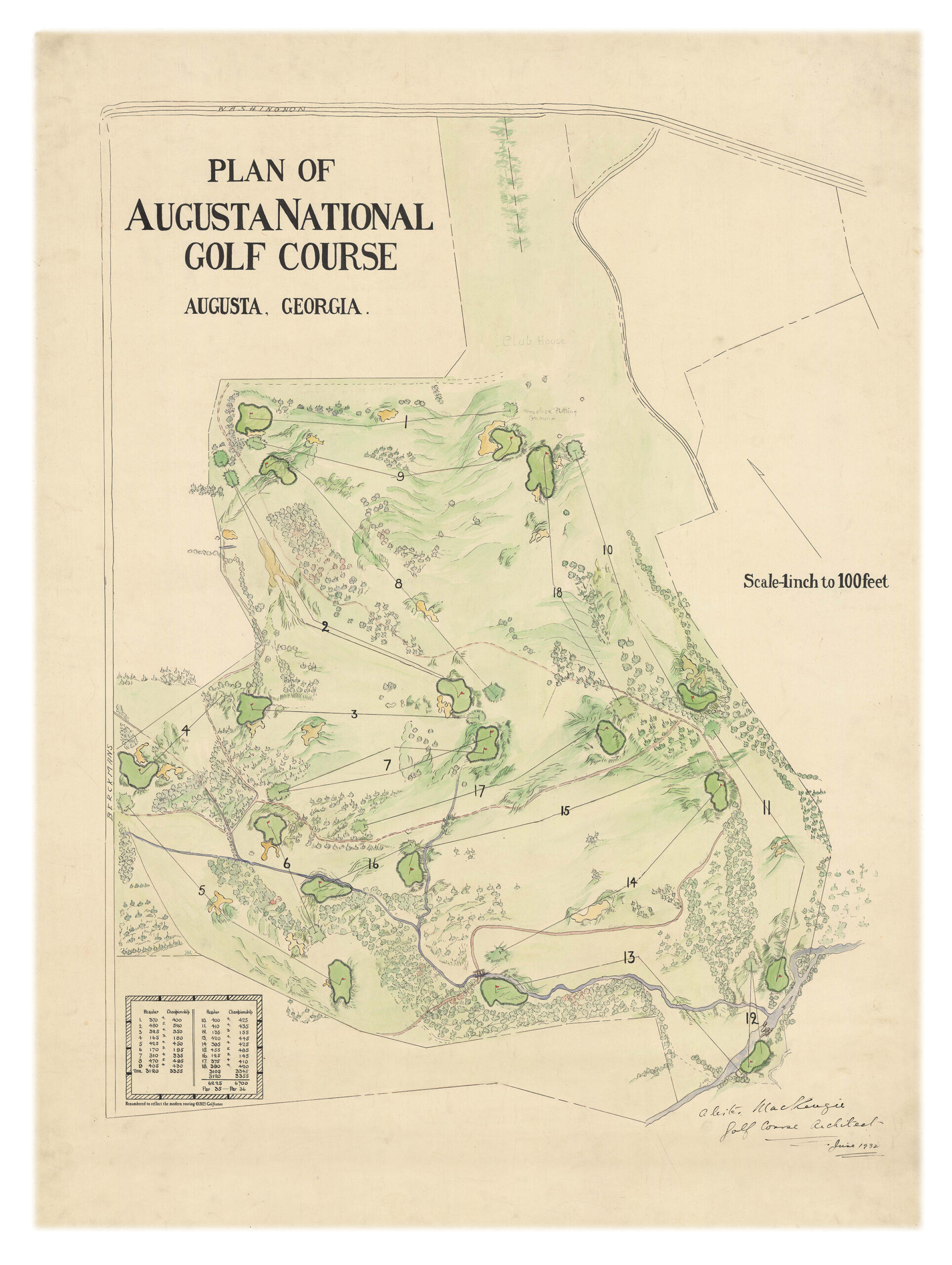by Forrest Richardson, ASGCA, Golf Course Architect
Golf course routing plans have always fascinated me. In fact, my first introduction to golf architecture was studying routing plans on scorecards, paper menus hijacked from grillrooms and — later on — whatever plans were reproduced on the pages of Golf Digest.
Not too long ago a plan caught my eye while researching the work of Alister MacKenzie. During my research I landed on an obscure website of the National Park Service’s Fredrick Law Olmsted National Historic Site. Among the collection of thousands of Olmsted plans and documents are several plans, photographs and letters pertaining to Augusta National Golf Club. One in particular is quite a gem. It’s the 1932 plan of Augusta National Golf Club, drawn in the unmistakable hand-inked and hand-drawn aesthetic of Dr. Alister MacKenzie. The large plan, more than four feet wide and nearly five feet in height, is signed by MacKenzie in the lower right. The Olmsted archives are a deep dive into the work of Frederick Law Olmsted and his firm that continued long after his passing in 1903. Considered the father of landscape architecture, Olmsted was a go-to designer of many of America’s most cherished landscapes. The firm’s work is carefully preserved at the archives, which today occupies “Fairsted,” the original Olmsted house (home office) located in Brookline, Massachusetts.
The Augusta plan is a remarkable work of art with detail worth noting. The concept of each green can be appreciated by way of hash marks depicting fall-offs, the blending of bunkers with fairways, and areas of creative mounding. MacKenzie illustrates wooded areas, the famous Rae’s Creek (hand-penciled with the simple word “Stream”) and his trademark bunkers. One can easily recognize that each bunker will be in magnificent harmony with greens and fairways. To me the word ‘harmony’ perhaps best describes what MacKenzie was trying to get across with the plan. As you study the lines, shapes and colors, ‘harmony’ sums it up nicely.
 Plan courtesy of the United States Department of the Interior, National Park Service,
Plan courtesy of the United States Department of the Interior, National Park Service,
Frederick Law Olmsted National Historic Site (renumbered to reflect the modern routing)
So, what is the Augusta plan doing at the Olmsted Archives? That requires a brief look at William Marquis, an Olmsted Brothers associate. Marquis was brought in to serve as the planner, helping to plan the golf club for its founders, the legendary amateur champion Bobby Jones, and Clifford Roberts, an investment banker from New York who would go on to run Augusta in the most intensive of details. Marquis was also given the tasks of devising plantings amongst the course and, perhaps most underrated, devising the system of ponds and water courses that flow through the lower holes. Today these waterways include more formal ponds, the streams widened at Holes 11, 12, 15 and 16. Some say that Marquis “partnered” with MacKenzie to fine tune Augusta’s routing. This is a reasonable conclusion. Reading the correspondence between Roberts and the Olmsted office gives one the feeling that the concept for the course was undoubtedly MacKenzie along with his clients, Jones and Roberts — but that Marquis was involved more than just a little.
A lot has changed at Augusta, but not the basic anatomy. Today the opening nine was the original inward nine, but that happens all the time. Ask any golf architect — they will relate an identical story of clubs swapping nines. The Augusta plan above was carefully re-tooled to reflect the modern routing, which, by the way, is not all that modern. Augusta changed the nines in 1934, within two years after opening. The realization was that frost on the shaded holes (today known as Amen Corner) would be less of an issue later in the day. Careful renumbering using all of MacKenzie’s hand-drawn numerals allows us to imagine the original design, but in more familiar terms.
Beyond the visual appeal of how MacKenzie communicates his design, take note of the functional beauty that is Augusta. The routing is magical. The plan hints at hills and valleys, with the clubhouse at the top and the famous 12th down below. One can appreciate the way MacKenzie gives the player descents and rises — and even both within the same hole. The formidable hillsides across Holes 1, 9 and 8 — and again at Holes 10 and 18 — are carefully indicated by MacKenzie as he visually describes Augusta on a flat piece of paper. There are splashes of color, but not too many. I’d like to think the pinkish tones are azaleas. Whatever, MacKenzie holds back and gives us a plan that is sensitive. If more golf plans today were soft and understated, they would reflect the environmental compatibility of the game. MacKenzie gets across his design but does so with restraint.
Best of all, you can find something new the more you study the plan. Which, aside from playing Augusta, may be a close second and one most all of us can appreciate.
